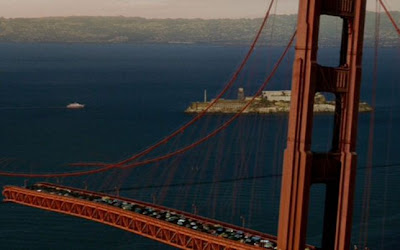Hidden gems and history lessons. Callbacks and cameo appearances. The X-Men movies are perhaps the most richly textured of all comic book franchises, with plenty of subtext and shout-outs for fans and non-fans alike. Take another look, though, and you'll see the films cribbing not just from themselves but from other popular series as well.
Fearful Symmetry
I spoke last time about the X-Men of First Class learning firsthand from President Kennedy, via television, of the impending Cuban Missile Crisis. Here it is again, in case you missed it:
Most of the characters from X-Men, as a matter of fact, gather important information from news on TV. In X2 (2003), Xavier and his students - on a field trip to their local science museum (actually The Plaza of Nations, Vancouver) - learn of Nightcrawler's attack on the White House via this emergency broadcast, which sets the entire plot in motion:
X-Men (2000) and X-Men: The Last Stand (2006) use TV to telegraph their climaxes well in advance. This is a literary device known as Chekhov's News - an off-handed way of presenting the audience with information that will become much more important later on. Early in X1, we get this report, of the upcoming "Peace Summit" on Ellis Island:
Later, of course, the X-Men are able to deduce Magneto's plan to mutate the summit leaders from his base atop the Statue of Liberty, and travel there to stop him:
In X3, Warren Worthington II holds this special press conference from his laboratory on Alcatraz Island, to announce his newly-concocted "mutant cure" to the public:
Note the Golden Gate Bridge in the background of the shot above, which Magneto repurposes for the movie's climactic assault on Alcatraz:
This so-called "cure," by the way, and the controversy it creates, makes explicit those themes of bigotry and hate which have always been so implicit in the comics. The Last Stand's telltale shots of picket lines and protesters owe their debt to countless civil rights demonstrations throughout human history:
The initial X-Men films also share similar plot structures - removing or otherwise incapacitating Professor X about halfway through the action, say, so that our heroes will be forced to regroup and strike back on their own:
Odd, too, how the best characters in each movie just happen to be blue:
Or how the filmmakers never seem to know what to do with Halle Berry's hair:
As film franchises go, X-Men isn't always as original as one might think. X-Men: First Class, for example, pays direct homage to the Sean Connery James Bond series of the 1960s (director Matthew Vaughn admitted as much during interviews, being an avid fan since childhood). Some have compared Connery's cold iconic reserve to Michael Fassbender's relentless revenge-seeking during Act One of First Class. An early costume change, however, makes the Connery connection even more explicit. Note Fassbender's tailored three-piece suit, practically stolen from Goldfinger (1964):
Kudos again to the prolific Todd Alcott for pointing out the above connection first. Vaughan takes his 007 fetish even further, with an end credits design obviously modeled after 1962's Dr. No:
Not even 007-style extravaganzas like Mission: Impossible are off-limits to the X-Men. These shots from The Wolverine (due July 26th; trailer released last week), seem inspired by Brian De Palma's famed bullet-train sequence from M:I 1 (1996):
2009's X-Men Origins: Wolverine, on the other hand, is the nadir. I honestly can't understand what anyone sees in this movie - the character cameos are pandering and perfunctory, those "special" effects look rushed and unfinished, and worse, Logan gets treated like a tennis ball all through the plot, flimflammed and bamboozled by everyone he comes into contact with.
I also wonder if Logan realizes that his entire prequel adventure has been cobbled together from other, better movies:
Saving Private Ryan (1998)
Batman Begins (2005)
The Last Of The Mohicans (1992)
Con Air (1997); The Rundown (2004)
Star Wars Episode I:
The Phantom Menace (1999)
Poor, put-upon Logan even turns out to be some sort of werewolf, for crying out loud, and can only be put down with
Proof that you can take the man's memories, but you can't erase the collective minds of us poor suckers in the audience.
__________
And with that, we conclude our X-Men retrospective. For Part One of our series, click here. For Part Two, here. And for our initial comic book-centric post that started it all, click here.









































Sports lovers can't get enough of Magis TV en Fire Stick—use code 730116, update to 5.0.2 for stable premium sports feeds in 4K. Free live channels, cheap VOD replays, control parental for kids—recommend SurfShark VPN to avoid ISP throttling!
ReplyDelete